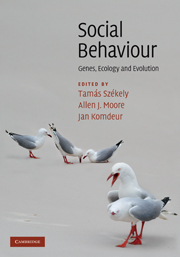Book contents
- Frontmatter
- Contents
- List of contributors
- Introduction: The uphill climb of sociobiology: towards a new synthesis
- Profile: Undiminished passion
- Part I Foundations
- Part II Themes
- Part III Implications
- 16 Personality and individual social specialisation
- Profile: Behavioural ecology, why do I love thee? Let me count the reasons
- 17 Molecular and genetic influences on the neural substrate of social cognition in humans
- Profile: Anonymous (and other) social experience and the evolution of cooperation by reciprocity
- 18 Population density, social behaviour and sex allocation
- Profile: Social theory based on natural selection
- 19 Social behaviour and speciation
- Profile: Look to the ants
- 20 Social behaviour in conservation
- Profile: The handicap principle and social behaviour
- 21 Prospects for research in social behaviour: systems biology meets behaviour
- Species index
- Subject index
- References
16 - Personality and individual social specialisation
Published online by Cambridge University Press: 05 June 2012
- Frontmatter
- Contents
- List of contributors
- Introduction: The uphill climb of sociobiology: towards a new synthesis
- Profile: Undiminished passion
- Part I Foundations
- Part II Themes
- Part III Implications
- 16 Personality and individual social specialisation
- Profile: Behavioural ecology, why do I love thee? Let me count the reasons
- 17 Molecular and genetic influences on the neural substrate of social cognition in humans
- Profile: Anonymous (and other) social experience and the evolution of cooperation by reciprocity
- 18 Population density, social behaviour and sex allocation
- Profile: Social theory based on natural selection
- 19 Social behaviour and speciation
- Profile: Look to the ants
- 20 Social behaviour in conservation
- Profile: The handicap principle and social behaviour
- 21 Prospects for research in social behaviour: systems biology meets behaviour
- Species index
- Subject index
- References
Summary
Overview
Animals differ in their behaviour, as humans differ in personality. Animal personality represents consistent behavioural individual differences over time and across contexts, and/or correlations between different types of behaviour. In many animal species, individuals differ in activity, aggressiveness, risk-taking and exploratory behaviour, and these behaviours are often positively correlated with each other. We therefore expect that personality affects social behaviour, and that social behaviour also influences personality. New discoveries about the evolutionary ecology of personality suggest exciting research opportunities on the effects of personality on the fate of individuals in social contexts, and on the influences of social interactions on development and evolution of personality.
Studying personality in a social context can provide new insights in the study of social behaviour because it allows us to consider one important question: are social groups composed of individuals with varying degrees of specialisation? Here we consider that the degree of specialisation of an individual for a given trait corresponds to the range of phenotypic expression of that trait for that individual relative to its population. A specialist for a trait is limited in its range of expression of that trait relative to its population, whereas a generalist expresses the whole range of phenotypic variation observed for that trait in the population.
- Type
- Chapter
- Information
- Social BehaviourGenes, Ecology and Evolution, pp. 417 - 441Publisher: Cambridge University PressPrint publication year: 2010
References
- 42
- Cited by



